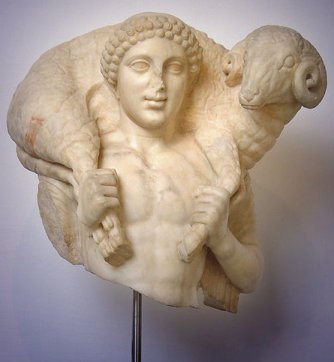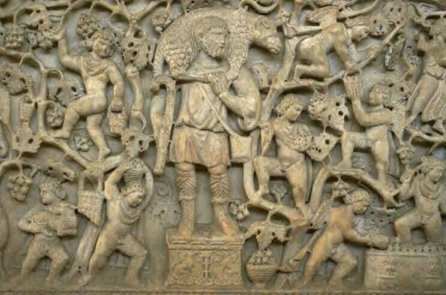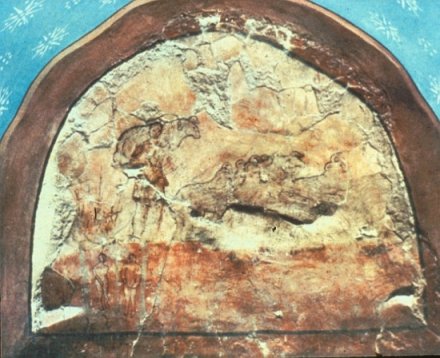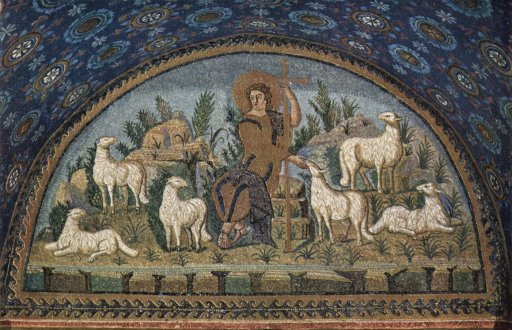|
Early Christian images |
|
|
For an excellent study of early Christian art in general I'd
recommend Understanding Early Christian Art by Robin Margaret
Jensen (Routledge). It has been enormously helpful in assembling this
page. The image of Christ as the Good Shepherd is frequently found as a wall decoration in the catacombs of Rome. Why was this image particularly popular? Compare the two images below. On the left is a late second/early third century wall painting of Christ as the Good Shepherd from the Catacomb of Priscilla. On the right is the image of Hermes we have already seen. The similarity is clear. |
|
|
|
|
| There are a number of possible reasons for the popularity of this
Christian image, of which deliberate ambiguity was certainly one. This
was a time of Christian persecution, when discretion in your choice of
image was clearly advantageous. In addition, Christian imagery was
largely undeveloped, and so it made sense to make use of what was
already available. The Hermes-Kriophoros symbol shared many of the same
virtues as the biblical Christ: watchfulness, caring, knowledge. Hermes was seen as a facilitator in the journey between this
world and the next, so an appropriate image for a tomb. The image also had biblical authority. Luke's gospel has the well-known 'lost sheep' parable: 'What man of you, having an hundred sheep, if he loses one of them, doth not leave the ninety and nine in the wilderness, and go after that which is lost, until he find it? And when he hath found it, he layeth it on his shoulders, rejoicing.' (15, 4 - 5) In John's gospel Jesus tells us 'I am the good shepherd, and I know my sheep, and am known of mine. As the Father knoweth me, even so I know the father: and I lay down my life for the sheep.' (10, 14 - 15) The text known as The Shepherd of Hermas (first or second century) was in the early days considered to have canonical status. Hermas, a humble slave, was visited by an angel in the form of a shepherd who taught him the precepts of Christianity. Shades of Gilgamesh? Many scholars feel that this text had a strong influence on the earliest Christian art. The use of the shepherd image was referred to by Tertullian in De Pudicitia (on Modesty), published in the late first or early second century. He tells us that the image was used on communion vessels to demonstrate that 'the flock is the people of the church, and the Good Shepherd is Christ.' Some catacomb images are even more strikingly classical in origin. This Christ image from the second century catacombs of Domitilla is clearly based on the Orpheus myth. |
|
|
|
|
| By the fourth century, Christianity was adopted as the official religion of the Roman Empire, thanks of course to Constantine. From now on Christian images would be more prominent, and more sophisticated, as in this carving from a fourth-century sarcophagus. |
|
|
|
|
| A
rare use of the Good Shepherd image is found in baptisteries. Jensen points out the connection between baptism and the
23rd psalm, the baptismal waters representing the psalm's still waters.
One of the very earliest images of the Good Shepherd comes from the
house church at Dura Europos, in Syria, dating from around 235. This is
now reconstructed in the museum at Yale University (left below). The
mosaic is later, dating from the fifth century, and comes
from the baptistery of S. Giovanni in Fonte in Naples. |
|
|
|
|
| For the finest of all Christian Good Shepherd images you need to go to the fifth century Mausoleum of Galla Placida in Ravenna. Here the classical trappings have entirely disappeared. A wonderful thing to see for real, but almost impossible to photograph. The mosaic is above the entrance, and no sooner have you focussed your camera than the curtain opens, some wretched tourist comes in, light pours everywhere, and the shot is ruined! So, the image below wasn't taken by this particular wretched tourist. |
|
|
|
|
| The finest Good shepherd - but is it the last? See the vanishing image next. |
|






